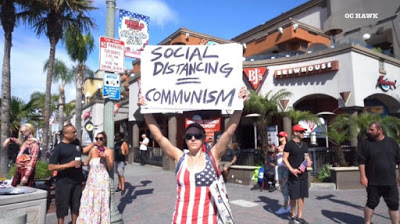Covid-19’s race and class warfare in USA
 |
| Charles M. Blow 04/05/2020 |
This crisis is exposing the savagery of American democracy.
People — mostly white, sometimes armed, occasionally carrying Confederate flags or hoisting placards emblazoned with a Nazi slogan from the Holocaust — have been loudly protesting to push their state governments to reopen business and spaces before enough progress has been made to contain the coronavirus. This is yet another illustration of the race and class divide this pandemic has illuminated in this country.
For some, a reopened economy and recreational landscape will mean the option to run a business, return to work, go to the park or beach, or have a night on the town at a nice restaurant or swanky bar. But for many on the lower rungs of the economic ladder, it will only force them back into compulsory exposure to more people, often in occupations that make it hard to protect oneself and that pay little for the risk.
Georgia was on the forefront of state reopenings. The first businesses that were allowed to reopen were, for the most part, those that provide low-wage jobs that require significant contact — like tattoo parlors, barbershops and hair salons, and nail shops.
These are the struggling workers who entertain and aestheticize people of means. These businesses were by no means essential, and they put these workers in danger. There is absolutely no way to practice social distancing while inking someone a tattoo. (Also, what are you so desperate to stamp on your body that you would risk it all during a pandemic?)
And many of the people doing these jobs will have to take public transit to get to work, and search for suitable child care before they leave home. Schools in most cases are still closed.
But, even among professions that we don’t immediately consider low-wage or minority-dominated, there are areas of high risk and low wages. For many people, the image that comes to mind about the medical field, those on the front lines, are doctors and nurses, people who are highly educated and highly paid. But there are many other people in those hospitals that make them run.
For instance, a majority of nursing assistants are members of racial minority groups. A third are African-American. Half have completed no formal education beyond high school. And, according to RegisteredNursing.org, the median annual wage for a nursing assistant in a hospital is just $30,000. For those in nursing homes and providing home care, the pay is even lower.
It has been widely reported that the virus is having a disproportionate impact on black and brown people in America, both in terms of infections and death. But that is only one aspect of the disparities. In a country where race and ethnicity often intersect with wealth and class, there are a cascade of other impacts, particularly economic ones, to remain conscious of.
In a Pew Research Center survey conducted last month, 52 percent of low-income workers said they or someone in their household had lost a job or taken a pay cut as a result of the pandemic. But, when you look at this through a racial lens, another striking reality emerges: 61 percent of Hispanic people agree with the statement, compared to 44 percent of African-Americans and just 38 percent of white people.
And, as Pew pointed out, “lower-income adults are less prepared to withstand a financial shock than those with higher incomes.”
A McKinsey and Company report last month found:
“Thirty-nine percent of jobs held by black workers, seven million jobs in all, are vulnerable as a result of the Covid-19 crisis, compared with 34 percent for white workers.”
Forty percent of the revenues of black-owned businesses are in the five most vulnerable sectors — including leisure, hospitality and retail — compared with 25 percent of the revenues of all U.S. businesses.
Beyond the threat to black personal economics, the crisis also poses a threat to black institutions. As the McKinsey report pointed out, the crisis is likely to “significantly — and quickly — hobble” historically black colleges and universities.
Even when the country starts to recover, the race and class disparities will most likely still be present and working against minorities in low-wage jobs. As the Center for American Progress wrote last month, “Evidence demonstrates that while workers of color are often the first to be fired during economic downturns, they are often the last to be rehired during recoveries.”
This pandemic is likely to not only expose inequalities, but also exacerbate them.
America has never been comfortable discussing the inequalities that America created, let alone addressing them. America loves a feel-good, forget-the-past-let’s-start-from-here mantra. But, this virus is exploiting these man-made inequalities and making them impossible to ignore. It is demonstrating the incalculable callousness of wealth and privilege that would willingly thrust the less well off into the most danger for a few creature comforts. This crisis is exposing the class savagery of American democracy and the economic carnage that it has always countenanced.


